After a cold Spring growth comes at last
Saturday, June 29, 2013
After months of waiting for the garden to really burst into life
at last the borders have started to fill and the veggies are
looking promising. It is good to report a better June than 2012
thanks to 2 weeks of sunshine at the beginning of the month and
rain just at the right time later on and the plant have responded
in spectacular style. We are still a couple of weeks behind where
we normally expect to be but who cares?!! There is lots to look
forward to and so much to write about that there isn't room to tell
you everything but I hope this news item conveys some of the joy we
feel after a long cold spring, and we hope you feel the same
too.
Weather
Warm days but cold nights until mid month with wind still mostly
from the north, but very good light levels from clear skies. Ground
dry enough to need watering regularly but then the rains took over,
the nights got warmer and growth went into overdrive. Warmest
temperature 22C on 4 June, lowest just 3C on 24 June
Garden update
Lawns looking fantastic just 3 months after their massive
makeover (see March News). Guru Rob has done his stuff and we are
so grateful to him, although he did confess the other day that he
had doubts early on if they would ever come back!
Say no more - job done!
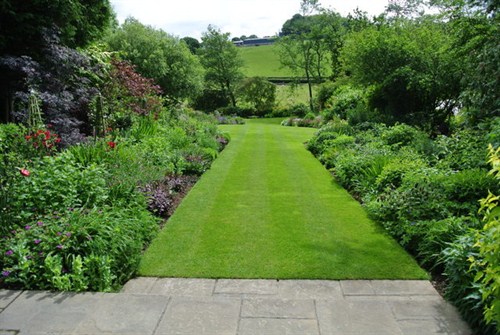
Vegetables, even though sown and planted late, have made up for
lost time and we are already harvesting some wonderful Hispi
cabbage, Mayflower cauliflower, lettuce in variety and radish.
Early potatoes (Maris Bard) and broccoli just a few days away.
Strawberries are very late but colouring at last and raspberries
are just beginning to set. Most veg planted in succession is
growing away but again parsnips had to be sown twice - nothing new
there! Some very promising carrots and peas though after the
disasters of last year.
Colourful rows of Webbs Wonderful, Lollo Rosso and
Imperial Green Cos
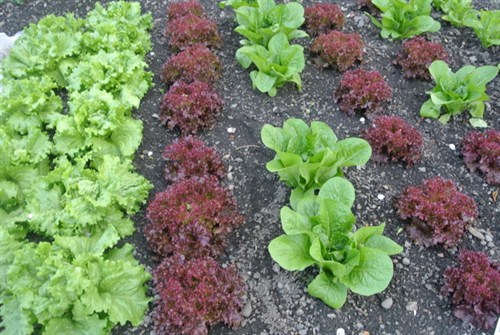
With the recent warmer nights I have been able to bring out the
hanging baskets, blue vein surfinia petunias as always, one under
each arch of the verandah. Single variety baskets are so much
easier then the mixed baskets I used to make in the early days at
Cilgwyn, each basket taking an hour, and none of them ever had the
wonderful scent of the blue vein baskets. In the wild in S.
America, petunia species are said to be scented but most modern
cultivars apart form Blue Vein seem to have lost this.
Other tender plants have gone into the borders, in particular
the various forms of salvias that are overwintered from cuttings
last autumn and which grow into large plants in 2 litre pots by the
middle of June. These make an immediate impact in every border into
which they are planted. They flower from about now until the
frosts.
On the subject of tender plants and S. America, I am really
excited that a plant of erythrina crista-galli (the cockspur coral
tree) which I have had in a pot in the large tunnel for 4 years is
now over 6' tall with a crown of buds on 2 strong stems. If I can
get this to flower I will be over the moon because it is a
magnificient infloresence with deep red pea like flowers that I
hope to be able to show you some time soon.
Aquilegias seem to have been in flower for ever and only started
to slow down in the last 2 weeks. We have had a fantastic range of
forms and colour especially some intriguing bi-colours including a
beige and apricot long spurred form that I generously sold recently
to one of our very grateful Dutch visitors who had the most
impecable taste!. I will be gathering seed to see what alchemy the
bees have been working in a couple of years time when the resultant
plants flower. I am not sure at my age it is altogether a good
thing to look forward that far but it sure gives you something to
hang on for!!
An American spurred hybrid form McKenna Giants
seed
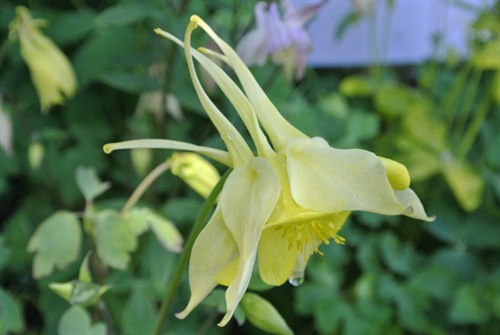
And a more familiar "Barlow" type

Just when everything had started to look wonderful in the garden
the bugs came along to spoil the party. Bugs in the form of capsid
bugs that are partial to growing tips in a wide variety of plants
especially fuchsias and dahlias, and a bug that likes only
daylilies - the dreaded hemerocallis gall midge. It lays its eggs
in the developing flower bud and when they hatch the grubs totally
destroy the flowers. I thought I had cracked this problem
last year but it has come back to bite me with a vengance and there
is no recognised treatment
Swiftly back to more positive news, the cardiocrinum giganteum
seed I sowed 4 years ago has grown into wonderfully glossy leaved
plants like giant hostas, which with luck in 2 or 3 years time
should produce their stems of up to 10 feet crowned with long stems
of the most beautifully scented white flowers. It is in the lily
family and I can't wait to see it. Gertrude grew them at Munstead
Wood and there is an iconic picture of her, a short lady, standing
alongside this giant plant. She has influenced, with a modern twist
here and there, my gardening style, and it was because of this
picture I was inspired to grow them. I have the picture somewhere
in one of her many books.
And finally under this heading what is this in the
picture?

Answer at the end of this months news item
What's looking good?!!
Hostas have rarely looked better and have grown enormously
in just a few weeks. Many of them didn't come properly into growth
until the beginning of the month and by doing so avoided the very
cold nights and dull days. Some long standing old favourites like
Sun Power, On Stage and Frances Williams have had as new lease of
life (all of them more than 15 years old) whilst the newer kids on
the block - Liberty, Bressingham Blue, Kiwi Full Monty and Marilyn
Monroe (yes honestly - all curves and white underskirts!!) are
trying to catch up the old ones.
Hostas in the north facing House Garden border. From the
bottom up, "June", "Golden Scepter", "Orange Marmalade", "Sun
Power" and just about visible "On Stage" always the latest to come
into leaf.
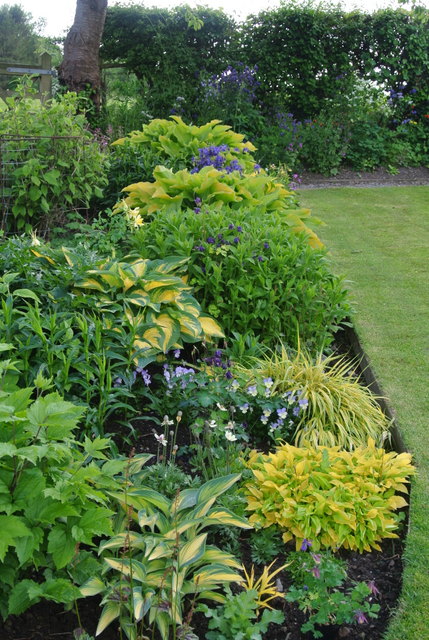
And a real giant "Snowden", a Britsh bred hosta,
Already 3 feet tall and of wonderful statuesque proportions (note
also the several arisaemas around it - they like each others
company!!)
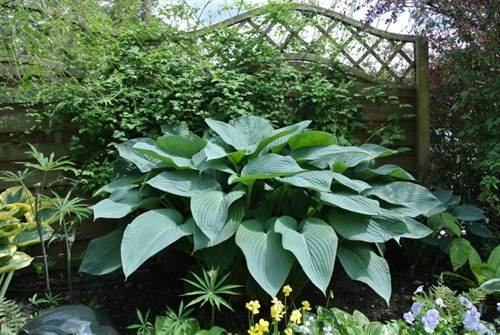
Lupins that I recently fell back in love with, having been put
off by lupin aphids some years ago, have been teriffic. In a
variety of shades they are very valuable early summer perennials
coming into flower before the main flush get into their stride.
A large stand of "The Governor" just 3 plants only 18
months old and dead easy from seed. £9.99 each in many garden
centres.

Poppies too have been very welcome with their opulent colours
from the deep red orientalis "Beauty of Livermere" to the
blue of meconopsis Lingholm hybrids with a few still flowering
(usually they have finished here by mid June). The Welsh poppies
too (meconopsis cambrica) have done well and our friends and
neighbours Roy and Barbara, have some marvellous double forms in
their garden, the flowers being twice the size of the single form,
and long lived because they are sterile.
Papaver orientale "Beauty of Livermere"

And Roy and Barbara's beautiful double yellow all the
work of pollinators, although this form can be obtained from a few
specialist nurseries.

Aquilegias in a huge range of colours and forms have flowered
throughout June and the long spurred American hybrids still have
some life left in them.
The small rock garden area is the only part of the gardens that
is full of colour at this time of year with a wide range of little
treasures.
Perhaps what pleases me most is the flowering of a batch of
lilium martagon var.album that I grew from seed sown in 2009. Not
only are they beautiful to look at but if you have the patience
they are considerably cheaper than buying flowering sized
bulbs.
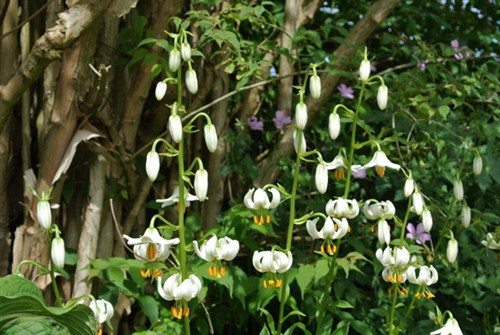
Regular readers of these news items will know that I sow many
varieties of seed each year, some of which flower in their first
year and others like clematis and hellebores take considerably
longer. The thrill I get when these flower is immense.
The first flowering of a seed grown delphinium from the
gardens. Nothing remotely like it here so once again thanks to the
pollinators. What would we do without them?
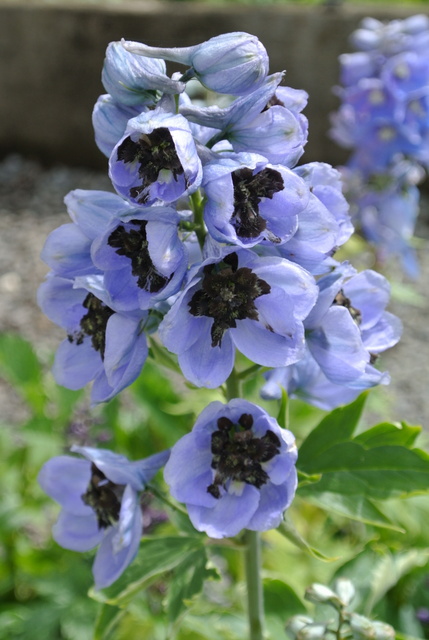
Wildlife and countryside
The tadpoles in the Paddock Pond are at different stages of
development; the frogs have all their legs and some are venturing
out of the pond for the first time. They seem to go back and
forward for a couple of weeks before leaving for
good.
The toads are a long way behind the frogs after a late spawning.
Newts have " tadpoles" too which are less showy than frogs and
toads, and take a longer time to become newts. Only common newts -
I am always on the look out (without success so far) for any great
crested newts that I used to catch in great quantities in a old
brickyard pool near to my childhood home in Gloucestershire.
On warmer days there are damselflies over the pond but as yet no
dragonflies which are always later. There have also been no blue
demoiselles yet which is strange as they are usually one of the
first to put in an appearance.
A delicate damselfly rests on a leaf before flying onto
the pond for egg laying
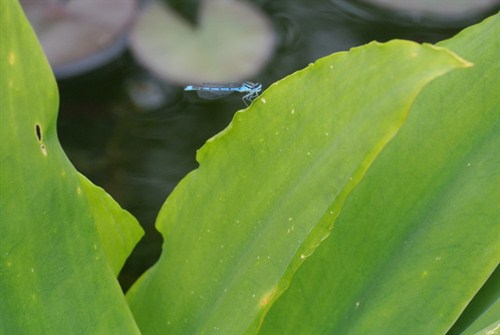
Two pairs of blue tits successfully raised their broods in the
stone shed by the house and a first time nesting in the garden by a
pair of redstarts who also chose the shed in which to raise their
brood. We also sighted a greater spotted woodpecker in the gardens
on several occasions which have been very infrequent visitors over
the years.
There have been plenty of bumble bees in the gardens which
is very encuraging and they seem to be on the wing even on the
duller days when the honey bees are absent. One of the bumble bees'
favourite flowers is the lupin where their greater weight enables
them to open the tightly closed flowers to gain access to the
pollen and as a by product, to ensure more seeds for me for next
year!!
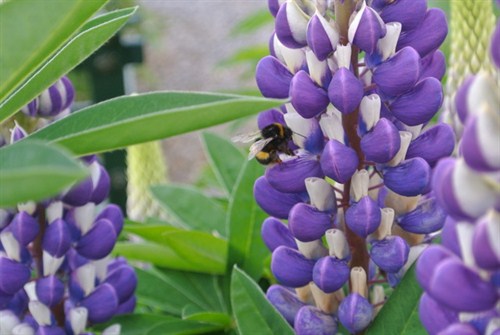
In the wider countryside it has been fairly quiet with less
rabbits about than last year (I say that very cautiously!!).
There has been very little silage harvest because of the
changeable weather and the fact that many of my farmer neighbours
had to graze so late.
The lambs have mostly been drawn from their mothers meaning a
quiter time for them and us!
Visits and visitors
The National Gardens Scheme (NGS) openings began on 5 June and
there have been 4 visits this month including one from Saga
Holidays and two from Holland, all thank goodness in fine weather.
July is our busiest month with group visits including our first
from Germany. This is our 14th year of opening for the Scheme and
it still gives us pleasure to welcome visitors and raise money for
the charities supported by the NGS . We have raised over £20,000
since we first started opening in 2000. We are often asked by local
people when we are having an Open Day. We know how much
pleasure these openings gave and are sorry that we no longer have a
dedicated Open Day but it was becoming difficult to cope with the
increasing numbers of visitors we had each year and to cater for
teas, car parking and plant sales. We also have less helpers
available. Local people are neverthless welcome to visit us by
prior arrangement as groups or individuals.
In a busy month we managed to find time to get away for a night
to visit RHS Rosemoor in Devon taking in Hestercombe Gardens,
Taunton, said to be Lutyens and Jekylls finest creation. Although
the latter is good especially the areas where their quality shines
through, Rosemoor is quite superb - all 46 acres of it.
Imaginatively planted, beautifully maintained and full of a range
of plants to delight even the most demanding of plantsmen (or
women!). If that wasn't enough helpful staff, a great restaurant
and the most magical valley setting on a still, moist, humid day. I
can't recommend it enough.
Classic lines of Gertrude's rose, iris and peony border
at Hestercombe exactly as she planned it 100 years on.
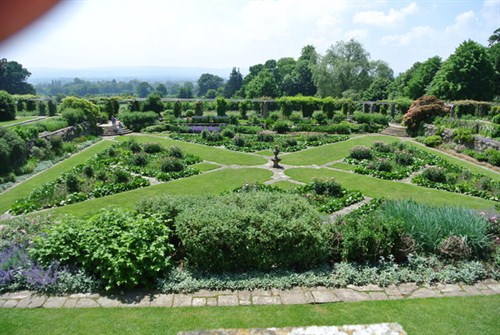
One of the model gardens at Rosemoor. There are a
string of these in the new part of the garden started 25 years ago
when the RHS acquired the garden.

A quiet corner of the ornamental kitchen garden.
Foxgloves and perennial stocks are used to raise the colour
threshold, provide height and scent, and to
attract pollinators into the garden
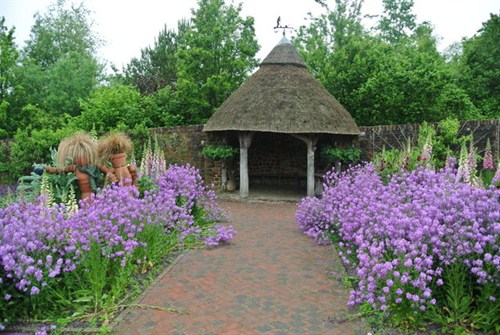
And in the shelter of the thatched gazebo an old
gardening friend to talk to. Quite difficult to discern the
difference I know but I am the one on the left!!

AND FINALLY THE ANSWER TO THE QUIZ QUESTION
It is the emerging flower bud of hosta "Bressingham
Blue" - it looks more like a sacred lotus!